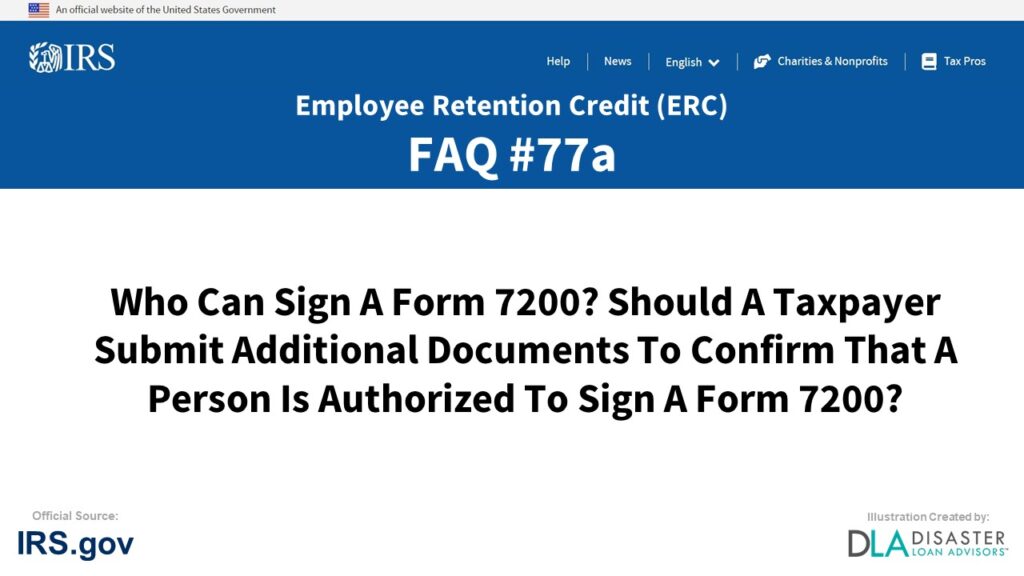
Frequently asked question #77a “Who can sign a Form 7200? Should a taxpayer submit additional documents to confirm that a person is authorized to sign a Form 7200?” under the How to Claim the Employee Retention Credit section of FAQs: Employee Retention Credit under the CARES Act, provided by the IRS.gov to help business owners understand the ERC program. Information is below for the question #77a Who can sign a Form 7200? Should a taxpayer submit additional documents to confirm that a person is authorized to sign a Form 7200?
ERC Credit Frequently Asked Question #77a:
COVID-19-Related Employee Retention Credits:
How to Claim the Employee Retention Credit FAQs
77a. Who can sign a Form 7200? Should a taxpayer submit additional documents to confirm that a person is authorized to sign a Form 7200?
The instructions for Form 7200, Advance Payment of Employer Credits Due to COVID-19, provide information on who may properly sign a Form 7200 for each type of entity. For corporations, the instructions provide that the president, vice president, or other principal officer who is duly authorized may sign a Form 7200.
For partnerships (including an LLC treated as a partnership) or unincorporated organizations, a responsible and duly authorized partner, member, or officer having knowledge of the entity’s affairs may sign a Form 7200.
For a single-member LLC treated as a disregarded entity for federal income tax purposes, the instructions provide that the owner or a principal officer who is duly authorized may sign the Form.
For trusts or estates, the instructions provide that the fiduciary may sign the Form 7200. Additionally, the instructions provide that a Form 7200 may be signed by a duly authorized agent of the taxpayer if a valid power of attorney has been filed.
In many circumstances, whether the person signing the Form 7200 is duly authorized or has knowledge of the partnership’s or unincorporated organization’s affairs is not apparent on the Form 7200.
To help expedite and ensure proper processing of Forms 7200, if a taxpayer has duly authorized an officer, partner, or member to sign Form 7200 (and that person is not otherwise explicitly permitted to sign the Form 7200 by nature of their job title), the taxpayer should submit a copy the Form 2848, Power of Attorney and Declaration of Representative, authorizing the person to sign the Form 7200 with the Form 7200.
For more Internal Revenue Service (IRS) Department of the Treasury Employee Retention Credit (ERC) How to Claim the Employee Retention Credit FAQs, visit the official IRS.gov tax website.
Conclusion and Summary on ERC Credit FAQ #77a. Who can sign a Form 7200? Should a taxpayer submit additional documents to confirm that a person is authorized to sign a Form 7200?
The “Who can sign a Form 7200? Should a taxpayer submit additional documents to confirm that a person is authorized to sign a Form 7200?” is Frequently Asked Question #77a of many commonly asked questions small business owners are wondering about how to file the Employee Retention Tax Credit (ERTC). The IRS ERC Tax Credit program is a confusing and complex process to determine the correct ERC calculations your business qualifies for. Answers to “Who can sign a Form 7200? Should a taxpayer submit additional documents to confirm that a person is authorized to sign a Form 7200?” and filling out form 941-X may change slightly from frequently updated rules and regulations from the IRS. Leave a comment below if you have further questions on ERC Credit FAQ #77a.
Help Completing / Filing / Claiming the Employee Retention Credit (ERC)
Receive Up to a $26,000 ERC Credit from the IRS Per Employee
Disaster Loan Advisors can assist your business with the complex and confusing Employee Retention Credit (ERC), Form 941-X, and the Employee Retention Tax Credit (ERTC) program.
Depending on eligibility, business owners and companies can receive up to $26,000 per employee based on the number of W2 employees you had on the payroll in 2020 and 2021.
The ERC / ERTC Tax Credit Program is a valuable IRS tax credit you can claim. This is money you have already paid to the IRS in payroll taxes for your W2 employees.
We DO NOT charge a percentage (%) of your ERC Refund like some companies are charging. Some ERC firms out there are charging upwards of 15% to 35% of your ERC refund!
Our professional ERC fee and pricing structure is very reasonable in comparison.
If you are looking for an ERC Company that believes in providing professional ERC Services and value, in exchange for a fair, reasonable, and ethical fee for the amount of work required, Disaster Loan Advisors is a good fit for you.
Schedule Your Free Employee Retention Credit Consultation to see what amount of employee retention tax credit your company qualifies for.
Cover Image Credit: Irs.gov / ERC FAQ / Disaster Loan Advisors.
